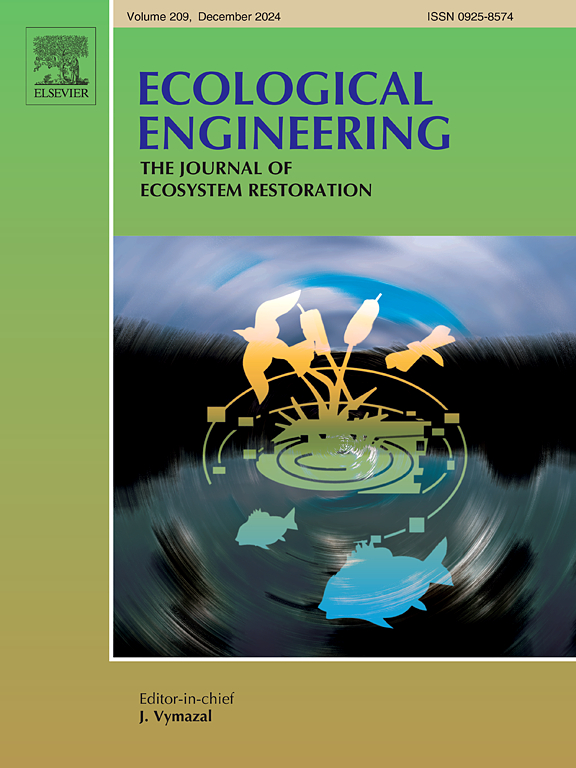一个小的、浅的、城市湖泊沉积物去除的长期水质响应
IF 4.1
2区 环境科学与生态学
Q1 ECOLOGY
引用次数: 0
摘要
沉积物去除是一种很有前途的湖泊恢复策略,它可能通过直接处理内部磷(P)负荷的来源来提供持久的水质改善。然而,需要更多的研究来评估干预结果的寿命,以有效地评估该方法的恢复性能。我们使用长期数据来评估芬兰南部Gallträsk小浅湖的沉积物去除对水质的影响,该湖在2009-2011年进行了吸力疏浚的沉积物去除。顶部50-100厘米的地表沉积物从湖泊总面积的18%中移除,以增加湖泊深度,用于娱乐目的。利用结构断裂和中断时间序列分析相结合的方法分析了沉积物去除前后的数据。我们的研究结果显示,去除沉积物后水柱P浓度显著降低,表明干预措施大大促进了湖泊从过去的负荷中恢复。此外,沉积物去除后悬浮物浓度降低,为淹没植物的再定殖创造了有利条件。干预后的水色和化学需氧量增加,可能是由于内部和外部驱动因素。氮(N)也不受泥沙去除的影响,氮磷比随之增加。抽吸疏浚后,水质和沉水植物丰度的长期变化导致了有害藻华的消失。我们的研究结果表明,沉积物去除可以使湖泊从遗留的磷负荷中长期恢复,并作为缓解富营养化的有力措施。本文章由计算机程序翻译,如有差异,请以英文原文为准。

Long-term water quality responses to sediment removal in a small, shallow, urban lake
Sediment removal is a promising strategy for lake restoration that potentially provides long-lasting water quality improvement by directly tackling the source of internal phosphorus (P) loading. However, more studies evaluating the longevity of intervention results are needed to viably assess the method's restoration performance. We used long-term data to evaluate the water quality impacts of sediment removal in small, shallow Lake Gallträsk in southern Finland, where sediment removal by suction dredging was conducted in 2009–2011. The top 50–100 cm of surface sediment was removed from 18 % of the lake's total area to increase the lake depth for recreational purposes. Data before and after sediment removal were analyzed using a combination of structural break and interrupted time series analyses. Our results revealed a significant reduction in the water column P concentration after sediment removal, suggesting that lake recovery from past loading was substantially promoted by the intervention. Additionally, suspended solid concentration reduced after sediment removal, enabling favorable conditions for submerged macrophyte recolonization. Water color and chemical oxygen demand increased after the intervention, possibly due to both internal and external drivers. Nitrogen (N), in turn, was not unaffected by the sediment removal, and the N/P ratio subsequently increased. The long-term changes in water quality and submerged macrophyte abundance after suction dredging have resulted in the absence of harmful algal blooms. Our results demonstrate that sediment removal can enable the long-term recovery of lakes from legacy P loading and act as a powerful measure to mitigate eutrophication.
求助全文
通过发布文献求助,成功后即可免费获取论文全文。
去求助
来源期刊

Ecological Engineering
环境科学-工程:环境
CiteScore
8.00
自引率
5.30%
发文量
293
审稿时长
57 days
期刊介绍:
Ecological engineering has been defined as the design of ecosystems for the mutual benefit of humans and nature. The journal is meant for ecologists who, because of their research interests or occupation, are involved in designing, monitoring, or restoring ecosystems, and can serve as a bridge between ecologists and engineers.
Specific topics covered in the journal include: habitat reconstruction; ecotechnology; synthetic ecology; bioengineering; restoration ecology; ecology conservation; ecosystem rehabilitation; stream and river restoration; reclamation ecology; non-renewable resource conservation. Descriptions of specific applications of ecological engineering are acceptable only when situated within context of adding novelty to current research and emphasizing ecosystem restoration. We do not accept purely descriptive reports on ecosystem structures (such as vegetation surveys), purely physical assessment of materials that can be used for ecological restoration, small-model studies carried out in the laboratory or greenhouse with artificial (waste)water or crop studies, or case studies on conventional wastewater treatment and eutrophication that do not offer an ecosystem restoration approach within the paper.
 求助内容:
求助内容: 应助结果提醒方式:
应助结果提醒方式:


